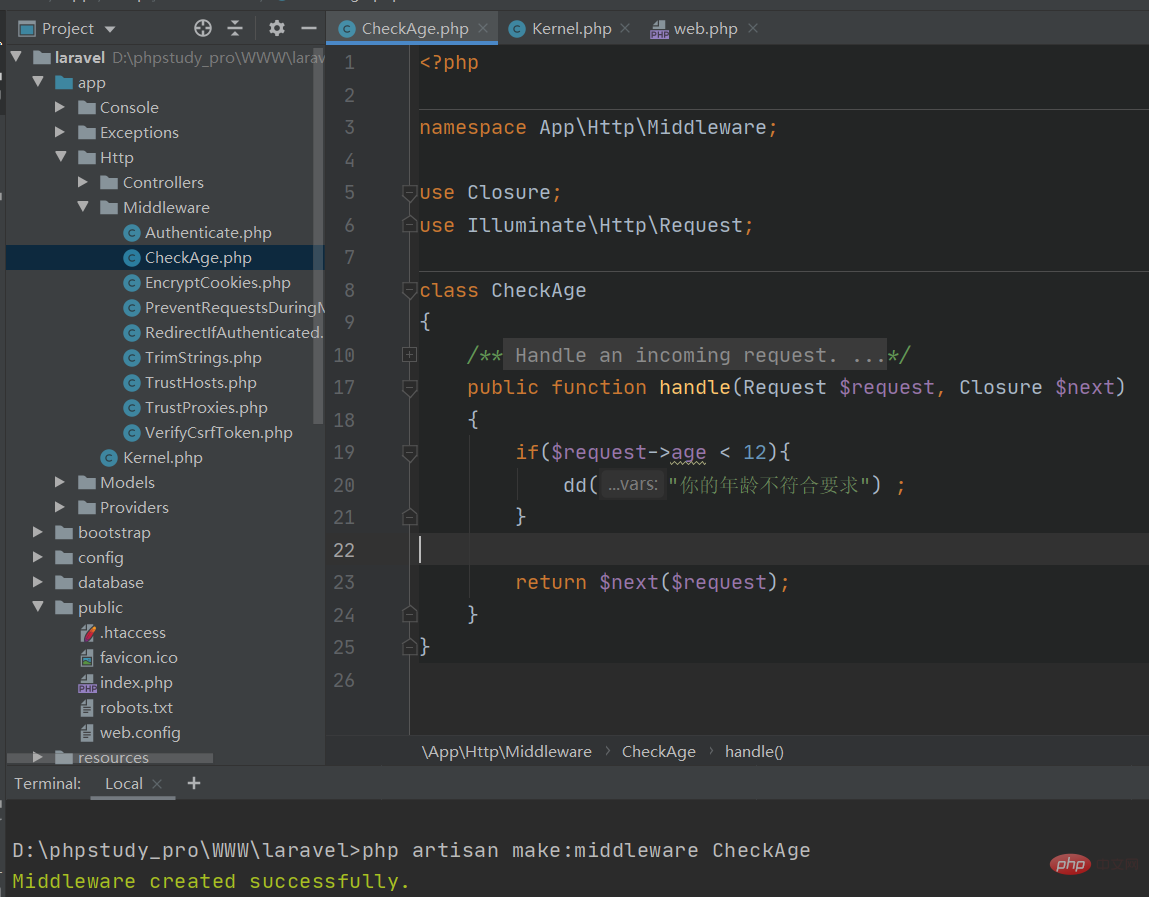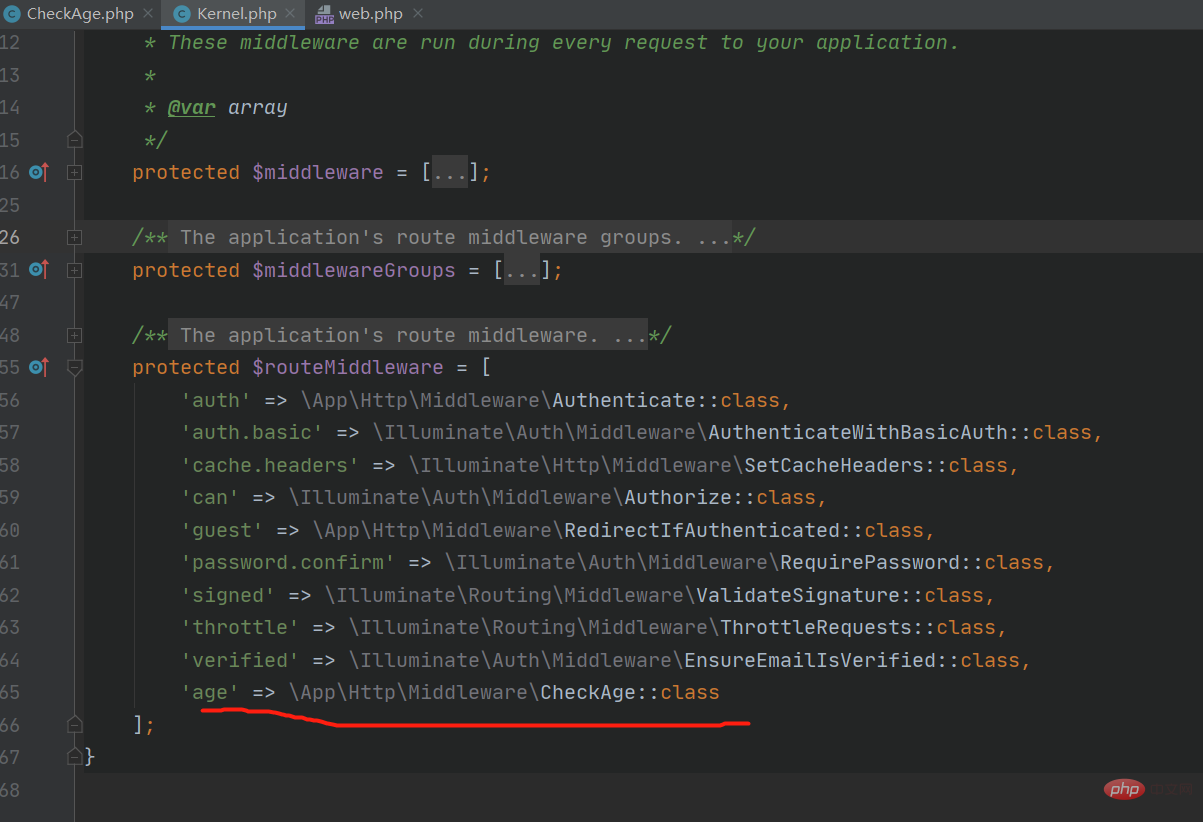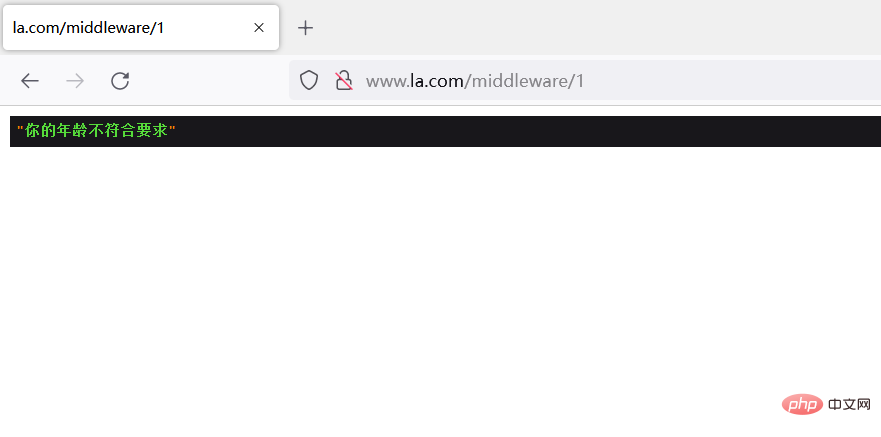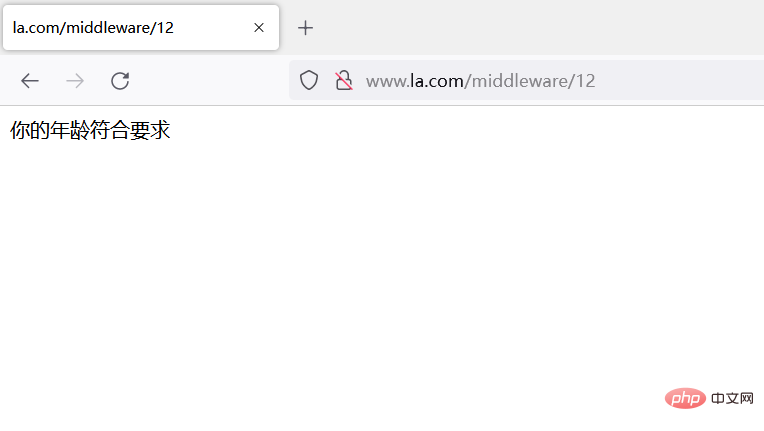Detailed explanation of laravel middleware basics
This article brings you relevant knowledge about laravel, which mainly introduces related issues about middleware, including what is middleware, custom middleware, etc., middleware It provides a convenient mechanism for filtering HTTP requests entering the application. Let's take a look at it. I hope it will be helpful to everyone.

【Related recommendations: laravel video tutorial】
What is middleware
Middleware Provides a convenient mechanism for filtering HTTP requests entering an application. For example, Laravel has a built-in middleware to verify whether the user is authenticated (such as logged in). If the user is not authenticated, the middleware will redirect the user to the login page; if the user has been authenticated, the middleware will allow the request. Continue forward to the next step. In addition to authentication functions, middleware can be used to handle many other tasks. For example, CORS middleware can add appropriate headers (cross-domain) to responses leaving the site; log middleware can record all requests entering the site, making it easier for us to build a system log system.
Lavarel comes with some middleware, including authentication, CSRF protection middleware, etc. All middleware is located in the app\Http\Middleware directory.
1. Customize middleware
Steps:
- Use artisan command to create middleware
php artisan make:middleware middleware name - Write logic in the created middleware
- Register the middleware in the configuration file Kernel.php in the app\Http folder
- Assign the middleware to Router or controller
2. For example
For example, some items in the amusement park require 12 years old or a height of more than 1.4 meters to play.
We create a middleware for age verification
php artisan make:middleware CheckAge

Closure is a closure function
$request is used to receive application requests Array
$next Pass the request to the application
$next($request) Pass the request to the application
public function handle(Request $request, Closure $next)
{
if($request->age <h3 id="Register-middleware">Register middleware</h3><p>Open app\Http The configuration file Kernel.php</p><blockquote><p>$middleware in the folder configures global middleware. All http requests need to go through the middleware we defined. <br> $middlewareGroupsMiddleware Group<br> $routeMiddleware Define alias</p></blockquote><pre class="brush:php;toolbar:false">'age' => \App\Http\Middleware\CheckAge::class
Open web.php to create a route
//中间件Route::get('middleware/{age}',function () {
return "你的年龄符合要求";})->middleware('age');Test
http://www.la.com/middleware/1
http://www.la.com/middleware/12
【Related recommendations: laravel video tutorial】
The above is the detailed content of Detailed explanation of laravel middleware basics. For more information, please follow other related articles on the PHP Chinese website!

Hot AI Tools

Undresser.AI Undress
AI-powered app for creating realistic nude photos

AI Clothes Remover
Online AI tool for removing clothes from photos.

Undress AI Tool
Undress images for free

Clothoff.io
AI clothes remover

AI Hentai Generator
Generate AI Hentai for free.

Hot Article

Hot Tools

Notepad++7.3.1
Easy-to-use and free code editor

SublimeText3 Chinese version
Chinese version, very easy to use

Zend Studio 13.0.1
Powerful PHP integrated development environment

Dreamweaver CS6
Visual web development tools

SublimeText3 Mac version
God-level code editing software (SublimeText3)

Hot Topics
 1386
1386
 52
52
 Laravel - Artisan Commands
Aug 27, 2024 am 10:51 AM
Laravel - Artisan Commands
Aug 27, 2024 am 10:51 AM
Laravel - Artisan Commands - Laravel 5.7 comes with new way of treating and testing new commands. It includes a new feature of testing artisan commands and the demonstration is mentioned below ?
 Laravel - Pagination Customizations
Aug 27, 2024 am 10:51 AM
Laravel - Pagination Customizations
Aug 27, 2024 am 10:51 AM
Laravel - Pagination Customizations - Laravel includes a feature of pagination which helps a user or a developer to include a pagination feature. Laravel paginator is integrated with the query builder and Eloquent ORM. The paginate method automatical
 How to get the return code when email sending fails in Laravel?
Apr 01, 2025 pm 02:45 PM
How to get the return code when email sending fails in Laravel?
Apr 01, 2025 pm 02:45 PM
Method for obtaining the return code when Laravel email sending fails. When using Laravel to develop applications, you often encounter situations where you need to send verification codes. And in reality...
 Laravel schedule task is not executed: What should I do if the task is not running after schedule: run command?
Mar 31, 2025 pm 11:24 PM
Laravel schedule task is not executed: What should I do if the task is not running after schedule: run command?
Mar 31, 2025 pm 11:24 PM
Laravel schedule task run unresponsive troubleshooting When using Laravel's schedule task scheduling, many developers will encounter this problem: schedule:run...
 In Laravel, how to deal with the situation where verification codes are failed to be sent by email?
Mar 31, 2025 pm 11:48 PM
In Laravel, how to deal with the situation where verification codes are failed to be sent by email?
Mar 31, 2025 pm 11:48 PM
The method of handling Laravel's email failure to send verification code is to use Laravel...
 How to implement the custom table function of clicking to add data in dcat admin?
Apr 01, 2025 am 07:09 AM
How to implement the custom table function of clicking to add data in dcat admin?
Apr 01, 2025 am 07:09 AM
How to implement the table function of custom click to add data in dcatadmin (laravel-admin) When using dcat...
 Laravel - Dump Server
Aug 27, 2024 am 10:51 AM
Laravel - Dump Server
Aug 27, 2024 am 10:51 AM
Laravel - Dump Server - Laravel dump server comes with the version of Laravel 5.7. The previous versions do not include any dump server. Dump server will be a development dependency in laravel/laravel composer file.
 Laravel Redis connection sharing: Why does the select method affect other connections?
Apr 01, 2025 am 07:45 AM
Laravel Redis connection sharing: Why does the select method affect other connections?
Apr 01, 2025 am 07:45 AM
The impact of sharing of Redis connections in Laravel framework and select methods When using Laravel framework and Redis, developers may encounter a problem: through configuration...




